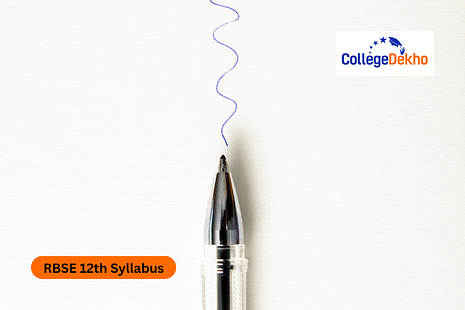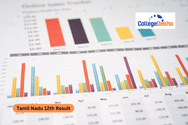RBSE 12th Syllabus 2024-25 for all subjects is provided in the article below. Students preparing for the upcoming RBSE 12th exam can also visit the official website to check and download the syllabus.


Never Miss an Exam Update
About RBSE 12th Syllabus 2024-25
The syllabus has been released by the Rajasthan Board on the official website. The detailed syllabus has been made available in PDF format on the official website at rajeduboard.rajasthan.gov.in. Through a shared file, students can also check the new curriculum and RBSE Class 12 Exam Pattern 2024-25 . Students can access the class 12 syllabus of the RBSE exam 2025 on the official website and this page as well. We provide the RBSE Class 12 Syllabus 2025 both in PDF and tabular form on this page. Students should carefully review the entire RBSE 12th Syllabus 2025 and plan their study schedule by it as they get ready for the RBSE 12th Board Exam 2025. The syllabus for the practical exams is also mentioned in the official curriculum PDF to be downloaded by the students. The syllabus will include information about the units and chapters included in the curriculum and also the chapters that have been omitted from the curriculum.
Since the RBSE Class 12 Syllabus is vast, students must ensure that they start with the RBSE Class 12 Preparations well in time to leave ample time for revision, towards the end. To effectively prepare, they must also go over the RBSE Class 12 exam pattern. On this page, we have included the RBSE class 12 syllabus 2025 for each of the major subjects. It is compulsory to appear for the practical exams and gain minimum passing marks to be eligible for the passing certificate. Check out more information about the RBSE 12th Syllabus 2024-25 here:
RBSE 12th Syllabus 2024-25: PDF
The board has released the RBSE 12th syllabus 2024–25, which students can download from the official website. The RBSE class 12 reduced syllabus 2024–25 comprises thorough curricula for every subject in the three primary streams—science, commerce, and the arts.
The official RBSE 12th reduced syllabus 2024–25 is available in PDF format in the table below. Before preparing for the RBSE 12th exam, students must adhere to the updated class 12 RBSE syllabus, as the question paper will be constructed using this syllabus.
RBSE 12th 2024-25 Syllabus: Stream-Wise Details
To get better grades, candidates must adhere to the RBSE class 12 reduced syllabus 2024–25. The details of each stream's syllabus are listed below, which students must refer to to receive higher grades.RBSE Class 12 Science Syllabus 2024-25
The RBSE Class 12 Science syllabus 2024-25 consists of mandatory subjects such as Mathematics, Biology, Physics, Chemistry etc. A chapter-wise marking scheme for theory exams, practical exams, and internal assessments is part of the updated curriculum for RBSE Class 12 2024–2025. The RBSE 12th science syllabus 2024–25 is provided below for candidates to review and plan their studies.RBSE 12th Syllabus 2024-25 for English
Reading, writing, and textbook will be the three sections of the English paper. The theory exam will be worth 80 marks, and students will have 3 hours and 15 minutes to complete all of the questions. For the RBSE Class 12 English Syllabus 2024-25 , see the table below.
| Sections | Topics |
|---|---|
| Reading | Two unseen passages (about 700-900 words in all) |
| Writing | Writing Compositions, Letters, Report writing |
| Flamingo Prose |
One extracts from different prose lessons included in Text Book (Approximately 100 words each) 4 comprehension questions testing local and global understanding and 2 questions on vocabulary—One testing the knowledge of similar words and the other testing the knowledge of the opposite word.
(ii) One out of two Long Answer Type Questions based on the text to test global comprehension are to be answered in about 80 words. (iii) Two Short Answer Type Questions based on the lessons to be answered in about 20-25 words |
| Flamingo Poetry |
(I) One out of two references to the context from the prescribed poems.
(ii) One out of two Long Answer Type Questions based on the text to test global comprehension of about 80 words. (iii) Two Short Answer Type Questions to be answered in 20-25 words. |
| Vistas |
One out of two Long Answer Type Questions based on Supplementary Reader to test comprehension and extrapolation of theme, character, and incidents about 80 words.
Two Short Answer Type Questions to be answered in about 20-25 words. Six Multiple Choice Questions. |
RBSE 12th Syllabus 2024-25 for Chemistry
The following lists the chapters and unit-wise topics for the RBSE Class 12 Chemistry Syllabus 2024-255. For the benefit of the students, the RBSE 12th Chemistry exam marking scheme is listed below. Exam marks are divided into three categories: 56 for the theory section, 30 for the practical exam, and 14 for the internal assessment.
Unit | Topics |
|---|---|
Unit 1: Solutions | Types of solutions, expressing concentration of solutions, solubility, vapour pressure of liquid solution, ideal and non-ideal solutions, colligative properties and determination of molar mass, abnormal molar masses. |
Unit 2: Electrochemistry | Electrochemical Cells, Galvanic Cells, Nernst Equation, Conductance of Electrolytic Solutions, Electrolytic Cells and Electrolysis, Batteries, Fuel Cells, Corrosion. |
Unit 3: Chemical Kinetics | Rate of a Chemical Reaction, Factors Influencing Rate of a Reaction, Integrated Rate Equations, Temperature Dependence of the Rate of a Reaction, Collision Theory of Chemical Reactions. |
Unit 4: d and f Block Elements | Position in the Periodic Table, Electronic Configurations of the d-Block Elements, General Properties of the transition Elements (d-Block), Some Important Compounds of Transition Elements, The Lanthanoids, The Actinoids, Some Applications of d- and f-Block Elements. |
Unit 5: Coordination Compounds | Werner's Theory of Coordination Compounds, Definitions of Some Important Terms Pertaining to Coordination Compounds, Nomenclature of Coordination Compounds, Isomerism in Coordination Compounds, Bonding in Coordination Compounds, Bonding in Metal Carbonyls, Importance and Applications of Coordination Compounds. |
Unit 6: Haloalkanes and Haloarenes | Classification, Nomenclature, Nature of C-X Bond, Methods of Preparation of Haloalkanes, Preparation of Haloarenes, Physical Properties, Chemical Reactions, Polyhalogen Compounds. |
Unit 7: Alcohols, Phenols and Ethers | Classification, Nomenclature, Structures of Functional Groups, Alcohols and Phenols, Some Commercially Important Alcohols, Ethers. |
Unit 8: Aldehydes, Ketones and Carboxylic Acids | Nomenclature and Structure of Carbonyl Group, Preparation of Aldehydes and Ketones, Physical Properties, Chemical Reactions, Uses of Aldehydes and Ketones, Nomenclature and Structure of Carboxyl Group, Methods of Preparation of Carboxylic Acids, Physical Properties, Chemical Reactions, Uses of Carboxylic Acids, Benzene: Chemical Formula and Molecular Structure. |
Unit 9: Amines | Structure of Amines, Classification, Nomenclature, Preparation of Amines, Physical Properties, Chemical Reactions, Method of Preparation of Diazonium Salts, Physical Properties, Chemical Reactions, Importance of Diazonium Salts in Synthesis of Aromatic Compounds. |
Unit 10: Biomolecules | Carbohydrates, Proteins, Enzymes, Vitamins, Nucleic Acids, Hormones. |
RBSE 12th Syllabus 2024-25 for Physics
The following lists the chapters and unit-wise topics for the RBSE Class 12 Physics Syllabus 2024–2025. There are three sections in the Physics exam: thirty for the practical, forty for theory, and fourteen for internal assessment.
Chapter | Topics |
|---|---|
Chapter 1: Electric Charges and Fields | Electric charge, conductors and insulators, basic properties of electric charge, Coulomb’s law, forces between multiple charges, electric field, electric field lines, electric flux, electric dipole, dipole in a uniform external field, continuous charge distribution, Gauss’s law, applications of Gauss’s law. |
Chapter 2: Electrostatic Potential and Capacitance | Electrostatic Potential, Potential due to a Point Charge, Potential due to an Electric Dipole, Potential due to a System of Charges, Equipotential Surfaces, Potential Energy of a System of Charges, Potential Energy in an External Field, Electrostatics of Conductors, Dielectrics and Polarisation, Capacitors and Capacitance, The Parallel Plate Capacitor, Effect of Dielectric on Capacitance, Combination of Capacitors, Energy Stored in a Capacitor (only formula). |
Chapter 3: Current Electricity | Electric Current, Electric Currents in Conductors, Ohm’s law, Drift of Electrons and the Origin of Resistivity, Limitations of Ohm’s Law, Resistivity of Various Materials, Temperature Dependence of Resistivity, Electrical Energy, Power, Cells, emf, Internal Resistance, Cells in Series and in Parallel, Kirchhoff’s Rules, Wheatstone Bridge. |
Chapter 4: Moving Charges and Magnetism | Magnetic Force, Motion in a Magnetic Field, Magnetic Field due to a Current Element, Biot-Savart Law, Magnetic Field on the Axis of a Circular Current Loop, Ampere’s Circuital Law, The Solenoid, Force between Two Parallel Currents - the Ampere, Torque on Current Loop, Magnetic Dipole, The Moving Coil Galvanometer. |
Chapter 5: Magnetism and Matter | The Bar Magnet, Magnetism and Gauss’s Law, Magnetisation and Magnetic Intensity, Magnetic Properties of Materials. |
Chapter 6: Electromagnetic Induction | The Experiments of Faraday and Henry, Magnetic Flux, Faraday’s Law of Induction, Lenz’s Law and Conservation of Energy, Motional Electromotive Force, Inductance, AC Generator. |
Chapter 7: Alternating Current | AC Voltage Applied to a Resistor, Representation of AC Current and Voltage by Rotating Vectors — Phasors, AC Voltage Applied to an Inductor, AC Voltage Applied to a Capacitor, AC Voltage Applied to a Series LCR Circuit, Power in AC Circuit: The Power Factor, Transformers. |
Chapter 8: Electromagnetic Waves | Displacement Current, Electromagnetic Waves, Electromagnetic Spectrum. |
Chapter 9: Ray Optics and Optical Instruments | Reflection of Light by Spherical Mirrors, Refraction, Total Internal Reflection, Refraction at Spherical Surfaces and by Lenses, Refraction through a Prism, Optical Instruments. |
Chapter 10: Wave Optics | Huygens Principle, Refraction and Reflection of Plane Waves using Huygens Principle, Coherent and Incoherent Addition of Waves, Interference of Light Waves and Young’s Experiment, Diffraction, Polarisation. |
Chapter 11: Dual Nature of Radiation and Matter | Electron Emission, Photoelectric Effect, Experimental Study of Photoelectric Effect, Photoelectric Effect and Wave Theory of Light, Einstein’s Photoelectric Equation: Energy Quantum of Radiation, Particle Nature of Light: The Photon, Wave Nature of Matter. |
Chapter 12: Atoms | Alpha-particle scattering and Rutherford’s nuclear model of atom, atomic spectra, Bohr model of the hydrogen atom, the line spectra of the hydrogen atom, de Broglie’s explanation of Bohr’s second postulate of quantisation. |
Chapter 13: Nuclei | Atomic masses and composition of nucleus, size of the nucleus, mass energy and nuclear binding energy, nuclear force, radioactivity, nuclear energy. |
Chapter 14: Semiconductor Electronics: Materials, Devices and Simple Circuits | Classification of Metals, Conductors and Semiconductors, Intrinsic Semiconductor, Extrinsic Semiconductor, p-n Junction, Semiconductor Diode, Application of Junction Diode as a Rectifier. |
RBSE 12th Syllabus for Biology
The
RBSE class 12 biology syllabus 2024-25
is provided in the table below with the chapter-wise marking scheme. The Biology exam contains 56 marks for theory, 30 marks for practical, and 14 marks for internal evaluation.
| Chapters | Marks Allotment |
| Sexual Reproduction in Flowering Plants | 5 |
| Human Reproduction | 4 |
| Reproductive Health | 2 |
| Principles of Inheritance and Variation | 5 |
| Molecular Basis Of Inheritance | 6 |
| Evolution | 3 |
| Human Health and Disease | 6 |
| Microbes in Human Welfare | 5 |
| Biotechnology: Principles and Processes | 4 |
| Biotechnology and its Applications | 4 |
| Organisms and Population | 4 |
| Ecosystem | 5 |
| Biodiversity and Conservation | 3 |
| Total | 56 |
RBSE 12th Syllabus 2024-25 for Mathematics
The Mathematics syllabus for Rajasthan Board Class 12th consists of 100 marks, divided into an 80-mark theory paper and a 20-mark practical/viva. Both theory and practical exams should be passed by students. Refer to the following table for RBSE Class 12 Mathematics Syllabus 2024-25 for
| Units |
|---|
| Relations and Functions |
| Algebra |
| Calculus |
| Vectors and Three-Dimensional Geometry |
| Linear Programming |
| Probability |
| Total |
RBSE Class 12 Syllabus 2024-25 for Commerce
The key subjects included in the RBSE 12th Commerce syllabus 2024–25 are accounting, business studies, economics, statistics, mathematics, etc. Students should therefore review the provided syllabus and get ready.
RBSE 12th Syllabus 2024-25 for Economics
Microeconomics and Macroeconomics are the two components of the syllabus. The unit-wise marks distribution may be found in the RBSE Class 12 Economics Syllabus 2024-25 below:
Part A: Macroecnomics | ||
|---|---|---|
Unit 1: Macroeconomics | Chapter 1. INTRODUCTION Chapter 2. NATIONAL INCOME ACCOUNTING | Emergence of Macroeconomics, Context of the Present Book of Macroeconomics, Basic concepts in macroeconomics, Circular flow of income (two sector model); Methods of calculating National Income - Value Added or Product method, Expenditure method, Income method. Factor cost, basic prices and market prices, macreoeconomic identities, Real and Nominal GDP, GDP and Welfare. |
Unit 2: Money and Banking | Chapter 3. Money and Banking | Functions of Money, demand for money, supply of money, Money creation by the banking system : Balance Sheet of a Fictional Bank, Limits to Credit Creation and Money Multiplier, policy tools to control money supply |
Unit 3: Income and Employment | Chapter 4. Determination of Income and Employment | Aggregate demand and its components-consumption, investment, determination of Income in two sector model, Determination of equilibrium with price level, fixed effect of an autonomous change in aggregate |
Unit 4: Government Budget | Chapter 5. Government Budget and the Economy | Government budget - meaning, objectives and its components, Objectives of government budget, Classification of receipts , Classification of expenditure,Balanced, surplus, deficit Budget. Measures of government deficit. |
Unit 5: Open Economy | Chapter 6. Open Economy-Macroeconomics | Balance of payments, current account, capital account, balance of payments surplus and deficit. Foreign exchange market, Foreign exchange rate, Determination of exchange rate , merits and demerits of flexible and fixed exchange rate systems, managed floating. |
Part B: Introductory Microeconomics | ||
Unit 1: Introductory Microeconomics | Chapter 1. INTRODUCTION | A Simple Economy , Central Problems of an Economy , Organisation of Economic Activities ,The Centrally Planned Economy,The Market Economy, Positive and Normative Economics, Microeconomics and Macroeconomics. |
Unit 2: CONSUMER BEHAVIOUR | Chapter 2. THEORY OF CONSUMER BEHAVIOUR | Utility, Cardinal Utility Analysis, Ordinal Utility Analysis, The Consumer’s Budget, Budget Set and Budget Line, Changes in the Budget Set, Optimal Choice of the Consumer, Demand, Demand Curve and the Law of Demand, Deriving a Demand Curve from Indifference Curves and Budget Constraints, Normal and Inferior Goods, Substitutes and Complements, Shifts in the Demand Curve , Movements along the Demand Curve and Shifts in the Demand Curve, Market Demand, Elasticity of Demand, Elasticity along a Linear Demand Curve, Factors Determining Price Elasticity of Demand for a Good, Elasticity and Expenditure. |
Unit 3: CONCEPTS of PRODUCTION AND COSTS | Chapter 3. PRODUCTION AND COSTS |
Production Function. The Short Run and the Long Run. Total Product, Average
|
Unit 4: PERFECT COMPETITION | Chapter 4: THE THEORY OF THE FIRM UNDER PERFECT COMPETITION Supply.Chapter 5: MARKET EQUILIBRIUM Chapter 6. NON-COMPETITIVE MARKETS |
Perfect Competition: Defining Features, Revenue, Profit Maximization, The Profit Maximization Problem: Graphical Representation, Supply Curve of a Firm, Short Run Supply Curve of a Firm. Long Run Supply Curve of a Firm, The Shut Down Point, The Normal Profit and Break-even Point, Determinants of a Firm’s Supply Curve,
|
Equilibrium, Excess Demand, Excess Supply, Market Equilibrium: Fixed Number of Firms, Market Equilibrium: Free Entry and Exit, Applications, Price Ceiling Price Floor. Simple Monopoly in the Commodity Market, Market Demand Curve is the Average Revenue Curve, Total, Average, and Marginal Revenues, Marginal Revenue and Price Elasticity of Demand, Short Run Equilibrium of the Monopoly Firm, Other Non-perfectly Competitive Markets, Monopolistic Competition, Oligopoly | ||
RBSE 12th Syllabus 2024-25 for Business Studies
The subject of business studies is divided into eight units in the RBSE class 12 syllabus. In the table below, you'll find the RBSE Class 12 Business Studies Syllabus 2024-25 :
| Units |
|---|
| Nature and Significance of Management |
| Principles of Management |
| Business Environment |
| Planning |
| Organizing |
| Staffing |
| Directing |
| Controlling |
| Financial Management |
| Financial Markets |
| Marketing |
| Consumer Protection |
RBSE 12th Syllabus for Accountancy
Refer to the table below to learn more about the RBSE 12th syllabus 2024-25 for Accountancy subject.
| Parts | Units | Topics |
|---|---|---|
| Part A | I. Introduction to Partnership |
Definition, Types of Partnerships, Need Features, and Meaning.
Meaning of the contents and rules if a partnership deed is not present. Fixed and Variable Capital Accounts for Partners. Sharing of Profits and Losses Among Partners. The Appropriation Account. Interest on Drawings and Interest on Partners' Capital. Historical Adjustments/Adjustments in Account Closing. A partner is guaranteed a minimum profit. |
| II. Admission of New Partner |
Rights of a New Partner.
New Profit Sharing Ratio. Sacrificing Ratio. Goodwill- Meaning, Methods of Valuation, and Accounting Treatment of Goodwill. Revaluation of Assets and Liabilities. Revaluation Accounts and Memorandum Revaluation Account. Distribution of Accumulated Profit, Loss, or Reserve. Adjustment of Partners Capital Accounting Treatment of Change in Profit Sharing Ratio among Existing Partners | |
| III. Accounting for Retirement and Death of Partner |
Significance and Approaches for a Partner's Retirement.
The updated gain ratio and profit sharing ratio. Accounting Procedure for Goodwill in the Event of Partner Death or Retirement. Accounting treatment for reevaluating liabilities and revaluing assets. Accounting Treatment of Reserve for Retirement or Death and Accumulated Profit/Loss. Finding and paying the amount owed to a retiring or departed partner. | |
| IV. Company Accounts: Issue of Shares and Debentures |
Company: Definition, traits, categories, and categorization.
Shares as well as Share Types. Accounting for Shares Issued at Par and Premium. Accounting Treatment of Share Issues for Cash and Non-Cash Considerations. Both below and above the share subscription. Shares of Sweat Equity, Right Shares, Escrow Account, and Employee Stock Option Plan. Definition, Features, and Debenture Types. Accounting Approach to Debenture Issue. Accounting Treatment of Issue of Debentures for Consideration other than cash. Debenture disclosure on the balance sheet. Accounting Procedure for Debenture Interest. Deducting the Discount or Loss on Debenture Issue. | |
| V. Joint Venture Accounts |
Meaning and Introduction of Joint Venture
Methods of Accounting for Joint Venture Separate Books are Kept No Separate Books are Kept | |
| VI. Accounting for Non-Trading Organisations and Professional Persons |
The definition of a non-trading organization and the books they own.
Receipt and payment account preparation. Creating an account for income and expenses. Making the balance sheet. Creation of the opening and closing balance sheets using the income and expense accounts as well as the receipt and payment accounts. Disturbance between Income and Expenditure Account and Receipt and Payment Account. | |
| Part B | I. Application of Electronic Spreadsheet in Accounting |
Financial statements: their nature, objectives, definition, and characteristics.
The goals, advantages, constraints, and methodology of financial analysis. Financial Statement Analysis Techniques. Statement of Comparative Finances. Financial Statement in Common Size. |
| II. Ratio Analysis |
Meaning of Ratio Analysis
Meaning of Ratio and its Expression Objectives and Limitations of Ration Analysis Precaution in Using Ratios Classification of Ratios: Liquidity Ratios Solvency Ratios Activity Ratios Profitability Ratios Investment Analysis Ratios | |
| Part C | I. Application of Electronic Spreadsheets in Accounting |
Utility of Spread Sheet.
|
| II. Computerized Accounting System |
Computerized Accounting System: Significance, Constituents, Functionalities, Advantages.
Process automation for accounting. Computerized Accounting System Composition. Accounting and Management Information Systems. Information System. Accounting software on a computer. Accounting systems that are computerized and manual. |
RBSE Class 12 Arts Syllabus 2024-25
The subjects covered in the RBSE class 12 arts syllabus 2024–25 include political science, economics, geography, and history. Candidates must therefore review and get ready for the following subjects.
RBSE 12th Syllabus 2024-25 for Political Science
Students should prepare for all subjects in the Arts streams to improve their RBSE 12th Arts results. One of the key subjects in this stream is Political Science. The following is the RBSE Class 12 Political Science Syllabus 2024-25 :
- Part A: Contemporary World-Politics (40 Marks)
Units | Topics |
|---|---|
Chapter 1: The End Of Bipolarity | What was the Soviet System?, Gorbachev and the Soviet Union disintegration, Why did the Soviet Union disintegrate?, Consequences of disintegration, Shock Therapy in post-communist regimes, Consequences of shock therapy, Tension and Conflicts, India and post communist countries. |
Chapter 2: Contemporary Centers Of Power | European Union, Associations of South East Asian Nations (ASEAN), the Rise of the Advertisement. |
Chapter 3: Contemporary South Asia | What is South Asia?, The Military and Democracy in Pakistan, Democracy in Bangladesh, Monarchy and Democracy in Nepal, Ethnic Conflict and Democracy in Sri Lanka, India-Pakistan Conflicts, India and its other neighbors, Peace and Cooperation. |
Chapter 4: International Organisations | Why international organizations?, Evolution of the UNO, Reform of the UNO After the cold war, Jurisdiction of the UNO, India and the UNO Reforms, The UNO in a unipolar world. |
Chapter 5: Security in the Contemporary World | What is Security?, Traditional Notions: External, Traditional Notions: Internal, Traditional Security and Cooperation, Non Traditional Notions, New Sources of threats, India's Security Strategy. |
Chapter 6: Environment and Natural Resources | Environmental Concerns in Global Politics, The protection of Global Commons, Common but Differentiated Responsibilities, Common Property, India’s stand on Environmental Issues, Environmental Movements: One or Many?, Resource Geopolitics, The Indigenous Peoples and Their Rights. |
Chapter 7: Globalisation | The Concept of Globalisation, Causes of Globalisation, Consequences of Globalisation, India and Globalisation, Resistance to Globalisation, India and Resistance to Globalisation. |
- Part B: Politics of India Since Independence (40 Marks)
Units | Topics |
|---|---|
Chapter 8: Challenges of Nation Building | Challenges for the new nation, Three Challenges, Partition: Displacement and rehabilitation, Process of Partition, Consequences of Partition, Integration of Princely States, Government's approach, Reorganisations of States. |
Chapter 9: Era of One-Party Dominance | Challenge of Building democracy, Congress dominance in the first three general elections, Nature of Congress dominance, Emergence of opposition parties. |
Chapter 10: Politics of Planned Development | Political Contestation, The Early Initiatives, The first five year plan, Rapid Industrialisation, Decentralized planning. |
Chapter 11: India’s External Relations | International Context, The policy of non- alignment, Peace and Conflict with China, Wars and peace with Pakistan, India's nuclear policy. |
Chapter 12: Challenge to and Restoration of The Congress System | Challenge of political succession, Fourth general elections, 1967, Split in the Congress, the 1971 Election and Restoration of Congress. |
Chapter 13: The Crisis of the Democratic Order | Background to Emergency, Declaration of Emergency, Regarding Emergency, Politics after Emergency. |
Chapter 14: Regional Aspirations | Region and Nation, Jammu and Kashmir, Punjab, The north-east, Movements against outsiders, Accommodation and national integration. |
Chapter 15: Recent Developments in Indian Politics | Concept of the 1990’s, era of Coalitions, Alliance politics, Political rise of other backward classes, The Mandal commission, Communalism, Secularism, Democracy, Emergence of a new consensus. |
RBSE 12th Syllabus 2024-25 for Geography
The RBSE Geography class 12 syllabus 2024-25 includes Part A and Part B. Check the RBSE Class 12 Geography Syllabus 2024-25 here:
- Human Geography: Nature and Scope, People, Human Activities,
- THE WORLD POPULATION: DISTRIBUTION, DENSITY, AND GROWTH
- Population Composition
- Human Development
- Primary Activities
- Secondary activities
- Tertiary & Quaternary activities
- Transport & Communication
- International Trade
- Human settlements
- India: People and Economy
- Map Work on the identification of features based on the above units on the outline Political map of the World,
- Resources and Development
- Transport
- Communication and International Trade
- Geographical Perspective on Selected Issues and Problems
RBSE 12th Syllabus 2024-25 for History
The units and chapter-wise marking scheme for the
RBSE Class 12th History syllabus 2024–25
are listed below. There are 80 marks available for the theory portion of the history exam, which includes 5 marks for map work and 20 marks for internal assessment. According to the RBSE class 12 syllabus 2024–25, students can view the map work syllabus in the NCERT textbook.
| Units | Chapters | Marks Allotment |
| Themes in Indian History, Part I | The Harappan Civilisation - Bricks, Beads and Bones | 6 |
| Early States and Economies - Kings, Farmers and Towns | 6 | |
| Early Societies - Kinship, Caste, and Class (C. 600 BCE-600 CE) | 6 | |
| Thinkers, Beliefs, and Buildings - Cultural Developments | 7 | |
| Themes in Indian History, Part II | Through the Eyes of Travellers, Perceptions of Society | 6 |
| Sufi Traditions, Changes in Religious Beliefs and Devotional Texts (C. Eighth to Eighteenth Century) | 7 | |
| An Imperial Capital: Vijayanagara (c. Fourteenth to Sixteenth Century) | 6 | |
| Peasants, Zamindars and the State-Agrarian Society and the Mughal Empire (c. Sixteenth- Seventeenth Centuries) | 6 | |
| Themes in Indian History, Part III | Colonialism and the Countryside-Exploring Official Archives | 6 |
| Rebels and the Raj- The Revolt of 1857 and Its Representations | 6 | |
| Mahatma Gandhi and the Nationalist Movement: Civil Disobedience and Beyond | 7 | |
| Framing the Constitution - The Beginning of a New Era | 6 | |
| Map Work | 5 |
How to download RBSE 12th Syllabus 2024-25?
The complete syllabus must be carefully reviewed by students getting ready for the RBSE 12th exam, and their schedule should be adjusted accordingly. Additionally, the thorough instructions for downloading the RBSE 12th syllabus 2024–25 are provided below.
Step 1: Go to rajeduboard.rajasthan.gov.in, the board's official website.
Step2: Go to the main page and select the "अनुदेशिका 2020 एवं पाठयक्रम 2024–25" link in the left upper section.
Step 3: A screen link labeled "RBSE Syllabus 2024-25 Class 12" will appear.
Step 4: The PDF file for each subject will appear on the screen after you click the "Course 2024-25 for Class 12" link.
Step 5: Download the syllabus and start preparing for the board examination.
RBSE 12th Syllabus 2024-25: Preparation Tips
RBSE 12th Syllabus 2024-25 is vast. As a result, many students find it difficult to recall all of the topics on the syllabus. Here are some pointers to help you finish your syllabus on time and prepare for your board exam.
- Students may download the latest RBSE 12th Syllabus 2024-25 first.
- Ensure that you cover all of the topics on the syllabus.
- Examine the marking scheme for each subject and prioritize the chapters that are more important than others.
- Study through a systematic schedule and do not leave out any chapter for later.
- To refresh your mind, set aside time for physical and mental exercises. Try yoga or running.
- Make sure you finish the syllabus at least a month before the board exam. Practice model test papers to become familiar with the exam environment.
- Solve as many previous year question papers as you can for revision.
FAQs
By consulting the RBSE 12th Syllabus 2024-25, students can obtain information such as the chapters included in the subjects, duration of the paper, marking scheme of the subject and number of marks.
RBSE 12th Syllabus 2024-25 from the official website of the Rajasthan Board of Secondary Education.
RBSE 12th Syllabus 2024-25 is not particularly difficult. With special study plans and a zeal to complete the syllabus on time, students can easily get good marks on the result.
RBSE 12th Syllabus 2024-25 has been developed in Hindi as well as in English.
Was this article helpful?






















